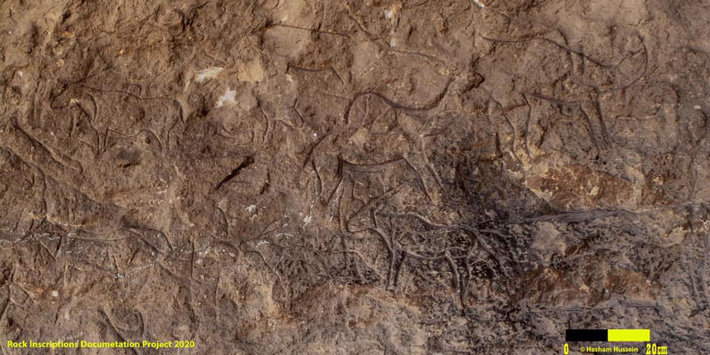Possibly 10,000-Year-old rock Art Discovered in Egyptian Cave
CAIRO, EGYPT—Egymonuments Reports that rock art has been discovered in a cave at Wadi Al-Zulma in North Sinai. Aymen Ashmawi of the Ministry of Antiquities said the images resemble a raised relief style and are thus different from those found in South Sinai.
Many of the newly found engravings depict animals, including camels, deer, mules, mountain goats, and donkeys. Remains of circular stone buildings have been found in the area of the cave.
The cave is located high on a hillside, overlooking the valley and it is made of limestone. It is quite difficult to access. The height of the cave is 60 feet (20 m) and 45 feet deep (15 m). In the cavern, the team of experts was shocked to find a large number of rock carvings that are of a type not seen before.

Ayman Ashmawy, a senior official with the Egyptian Ministry of Antiquities told Egypt Independent that ‘this cave is the first of its kind to be found in the area’.
Sinai has a great many rock carvings and an important collection of them was found at al-Zaranji cave, earlier this year, in the south of the peninsula.
Here a great many images were found that predated the Pharaohs and that possible date to 10,000 years ago. They were stylistically similar to other examples of cave art in the southern valleys of Sinai.

Ayman Ashmawy told Egypt Independent that the newly explored ‘cave features an utterly unique assortment of carvings unlike those from the South Sinai valleys’. There are a great many more engravings than in the al-Zaranji cave.
The Director of Sinai Antiquities and head of the mission, Dr. Hisham Hussein told Egypt Today that ‘most of the scenes were carved along the walls of the inner cave’.
The carved images found in Northern Sinai are different from those found elsewhere in the Peninsula. They are more akin to bas-relief and the figures tend to be projected out of the surface of the cave walls.
The rock art found elsewhere in the area, such as those at al-Zaranji were made by chipping away the rocky surface of the caverns and apply pigments to color the engravings.

Dr. Hisham told Ahram. online that the rock art depicts ‘animals, including camels, deer, mules, mountain goats and donkeys’. Some of the animals depicted have long ago disappeared from the area and this may help researchers to date the rock engravings.
Images of animals have also been uncovered in other caves in Sinai and other sites all around the world.
A great deal of animal waste and the remains of fires were found in the cave. This suggests that the local people still used the caves to shelter with their animals during the winter. It appears that the site had been used by people for millennia.

Ahram Online reports that ‘the remains of circular stone buildings were discovered’ and were unearthed near the location of the rock carvings. It was found some 140 feet (200 m) south of the site.
It is believed that these are the remains of an ancient settlement. It is not known if the settlement is contemporary with the rock art or if the people who lived there are responsible for the images deep in the limestone cave.
Dr. Hisham and his team will now record and catalogue the rock images. It is possible that more may be found elsewhere in the limestone cavern.
They will attempt to date the images based on their style and identify if they can be linked to any known historical society. It is too early to establish if the mysterious images were made by people from a previously unknown culture.
